HTC EVO 3D vs. Motorola Photon 4G: Choosing the Best Sprint Phone
by Anand Lal Shimpi on August 17, 2011 11:11 PM ESTPerformance
The Photon 4G uses NVIDIA's first mobile SoC with widespread acceptance: the Tegra 2. Although it only started appearing in Android phones and tablets this year, the design itself dates back to a year prior to its introduction. Despite its age, Tegra 2 does very well against the current competition. Its architecture is pretty simple to explain. You get a pair of ARM Cortex A9 cores running at up to 1GHz with a 1MB L2 cache shared between them. Although each core has a pipelined FPU, neither has ARM's MPE - a SIMD engine needed to run NEON code. NVIDIA built in a low power GeForce GPU into the Tegra 2 and while we've had complaints about it on tablets, at smartphone resolutions the ultra mobile GeForce seems to do reasonably well. Feeding the Tegra 2 is a single channel 32-bit LPDDR2 memory interface.
The EVO 3D on the other hand uses Qualcomm's latest SoC: the MSM8660, which falls under the new S3 brand. Here we also have two cores, although each one is a mostly in-order design running at 1.2GHz. NVIDIA originally told me that the move to out-of-order yielded a 20% increase in IPC at the same clock speed, so Qualcomm's 20% clock speed advantage should help level the playing field between the two on a CPU level. Qualcomm includes both a fully pipelined FPU as well as a NEON unit in each core, giving it an advantage in applications that are accelerated with NEON code. Admittedly to date there isn't a ton available to show where NEON can be advantageous so I don't know how much of an advantage this really ends up being. The two cores share a 512KB L2 cache but have a dual-channel memory interface.
Qualcomm is particularly proud of its ability to run each core at a frequency independent of the other. I haven't been able to demonstrate a tangible advantage to this feature yet and Qualcomm hasn't announced whether it will be present in future SoCs as well so the verdict is still out on this one.
The Adreno 220 is Qualcomm's highest end GPU (for now). Unfortunately we can't talk about its architecture as Qualcomm isn't publicly disclosing much but it is the fastest in the shipping Adreno lineup.
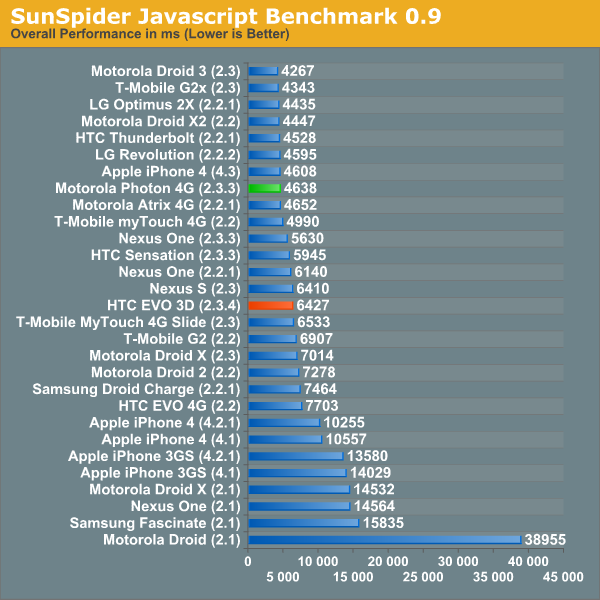
I already alluded to differences in the web browsers of these two phones resulting in varying javascript performance. HTC's browsers have traditionally not performed too well in our javascript tests and unfortunately the EVO 3D is no exception. In our tests it performed a bit worse than its counterpart, the Sensation. In any case, the Photon 4G has two advantages here: the out-of-order A9 architecture as well as a browser with a faster js engine. The comparison here isn't as cut and dry though. Although the EVO 3D's browser has a slower javascript engine, it does scroll smoother than the Photon's browser. The smoother scrolling on the EVO 3D is correctly encapsulated in the relevant scrolling tests in Qualcomm's Vellamo benchmark:
| Qualcomm Vellamo Benchmark - Scrolling Performance Tests | |||||
| Ocean Flinger | Image Flinger | Text Flinger | |||
| HTC EVO 3D | 68.98 | 26.03 | 41.79 | ||
| Motorola Photon 4G | 62.07 | 17.64 | 35.21 | ||
Despite Vellamo being a Qualcomm developed benchmark, the scores in these three tests do echo what I noticed after using the two phones. The EVO 3D's browser has better scrolling performance than the Photon. Neither is perfectly smooth, but the HTC browser is noticeably better than Motorola's.

BrowserMark echoes the javascript rendering advantage of the Photon.
Flash performance complicates things. The Photon has consistently better Flash performance regardless of benchmark. GUIMark 2's Vector Charting Test shows the biggest issue with the EVO 3D:
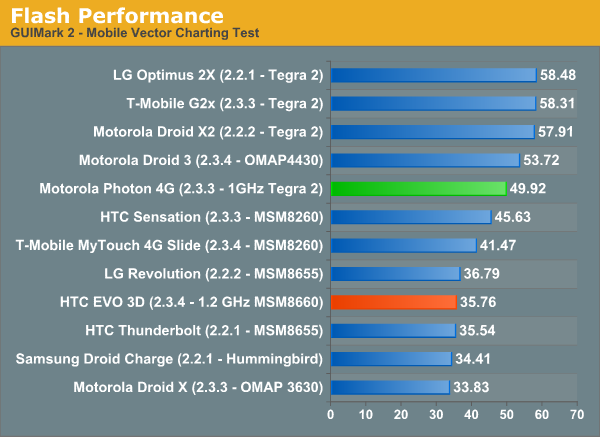
Although the EVO 3D reaches frame rates that are similar to the Photon, lots of stuttering pulls down the average frame rate to what you see above. NVIDIA's Tegra 2 is a clear winner when it comes to Flash performance. Only the OMAP 4 comes close. I'm not entirely sure why the Sensation does so well here, but there's a definite grouping of the Qualcomm based parts.
| GUIMark 3 Performance | ||||||||
| Bitmap - HTML5 Cached | Bitmap - Flash | Vector Test - HTML5 | Vector Test - Flash | Compute - HTML5 | Compute - Flash | |||
| HTC EVO 3D | 51.1 fps | 47.9 fps | 12.4 fps | 27.7 fps | 5.6 fps | 23.3 fps | ||
| Motorola Photon 4G | 37.3 fps | 45.4 fps | 12.1 fps | 35.4 fps | 6.8 fps | 31.3 fps | ||
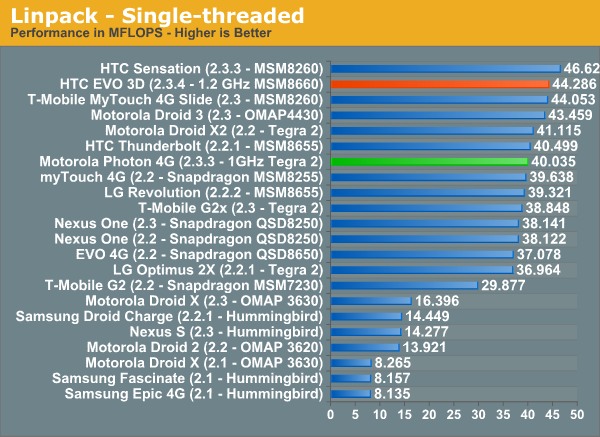

Linpack isn't all that useful of a benchmark under Android, but it does give us an idea of floating point performance of these two platforms. In both cases HTC pulls ahead, likely due to its clock speed advantage.
The GeForce in NVIDIA's Tegra 2 is growing old compared to the latest and greatest from Qualcomm and Imagination. Despite its age however, the Tegra 2 still holds its own pretty well among other qHD competitors. The Adreno 220 and SGX 540 are still faster in our tests though:
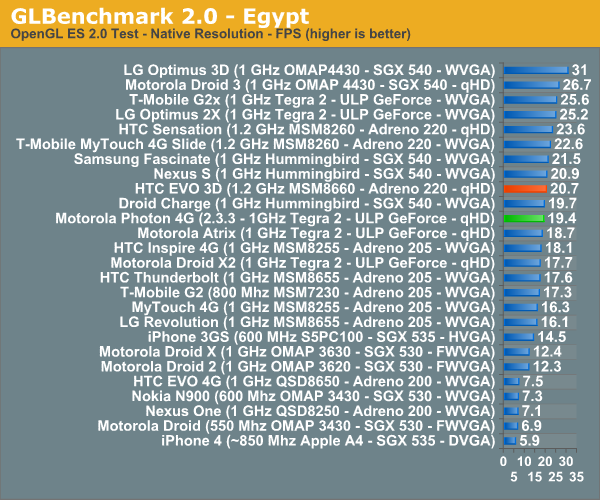
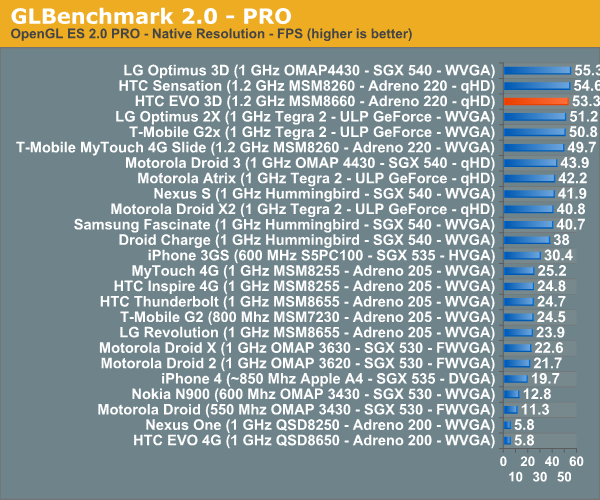
The huge advantage really comes from Basemark ES2 which seems to prefer deferred rendering architectures like the Adreno 220 and SGX 540 to NVIDIA's immediate mode renderer:
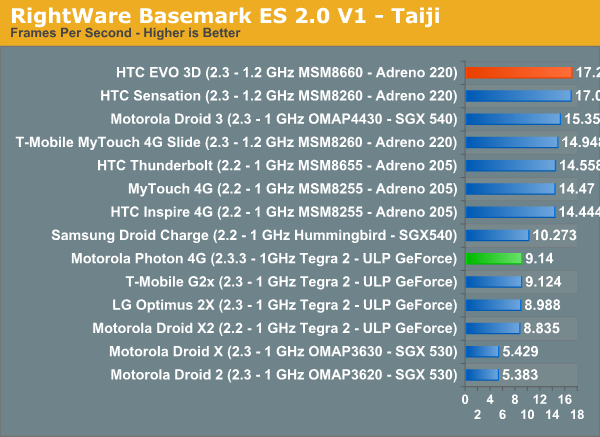
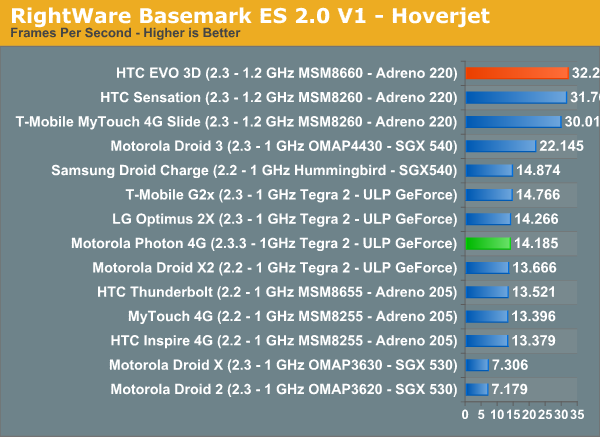
It's difficult to call an overall performance winner here. As we've seen throughout the review, both NVIDIA and Qualcomm trade blows here. The Tegra 2 based Photon 4G has the advantage in Flash and javascript performance while the Snapdragon based HTC delivers smoother browser scrolling and better 3D performance.










43 Comments
View All Comments
Someguyperson - Thursday, August 18, 2011 - link
I personally really like CF Bench. It gives a comprehensive breakdown of many, many criteria including my favourite tests, efficiency tests. It was also made by an XDA developer, so you know it's good.jonyah - Thursday, August 18, 2011 - link
I find it hard to believe the tegra2 can come anywhere close to the snapdragon in performance. My 2 tegra2 tablets (transformer and gt 10.1) are dog slow compared to my 3vo. Could that be because of honeycomb?Death666Angel - Thursday, August 18, 2011 - link
Hello!I am from Germany and I really don't get how the US cellphone market works. Here, I can either just buy any phone and get any contract with any carrier for that phone. Or I can buy a phone via carrier (anywhere between 1€ and ~200€ for smartphones) and get a contract to go along with that (sometimes that are locked to that carrier (SIM lock) but the carrier I have doesn't do that and it's easy to get around). However, that same contract is going to cost about 10, 15, 20, 25€ more than without a new phone, so over the course of the 24 month contract it usually comes out to mean that the phone via contract cost a bit more than the phone off contract. Sometimes people get lucky and you get a phone-contract-deal that works out to be cheaper over 24 months than if you had actually bought the phone yourself, they are referred to as "Schubladenvertrag" ~ contract for the drawer, because you just use it to get the phone cheaply).
Most carriers however carry pretty much all phones that are on the market with the exception of a few carrier specific ones (T-Mobile hat the G1, first Android phone here I think and until last year or so, the iPhone4 was also T-Mobile only). And if they don't carry it I can always buy it on my own and get a contract with them anyway.
Also, if you buy a data plan here you usually get a flat-rate and it runs high speed up to xxx MB (300, 500, 1GB, 2GB, 5GB are common break points) and then throttles down, but you won't have to pay any more money.
From the reviews it seems that the US market works differently somehow. I would like to hear more about it from you guys. :-)
P.S.: Going to read the review now, wanted to comment beforehand!
sprockkets - Thursday, August 18, 2011 - link
Basically, it works like this: Our government allows the telcos to screw us over.http://www.pbs.org/cringely/pulpit/2007/pulpit_200...
manthas - Thursday, August 18, 2011 - link
The GLBenchmark 2.0 - PRO is missing the Motorola Photon entirely. I suspect it sits right next to the Atrix performance wise, but very odd considering the subject of the article.fic2 - Thursday, August 18, 2011 - link
I find it interesting that the Photon is basically a world phone. I didn't think that Sprint sold any phones that could be used anywhere. Definitely makes it interesting.Impulses - Thursday, August 18, 2011 - link
Motor XPRT is also a world phone and has been out for months (small Android phone with portrait QWERTY), they've had various Blackberry world phones in the past too. Honestly, i think Sprint has had one of the best phone lineups over the last 12-24 months, if not the best.They had the Hero when AT&T still didn't have any Android phones (and before the Droid came out). Around that time they also scored the Pre exclusive (which may ultimately have helped Palm's demise, but nonetheless). When Android competition really heated up last year they came out with two phones that really complement themselves in the Epic & EVO, both had front facing cameras and 4G.
I dont think any other carrier could claim having both a slab and slider with top shelf specs and features like that. T-Mo had competing devices in ththe Vibrant and G2 but neither had front facing cameras and the Vibrant didn't have HSPA+. Similar scenario for VZW with the Droid X etc. Heck AT&T just had the Captivate for the longest time as it's only worthwhile Android phone.
VZW probably has the biggest lineup but it's not always the most varied, too many mid-to-high end slabs and not enough sliders and low end models. T-Mobile's G-line with plain Android builds has it's own appeal, but Sprint has had a nice balance and plenty of mid range models to complement it's high end.
Heck, VZW and AT&T still have only one dual core phone each no? To Sprint & T-Mobile's two apiece...
MilwaukeeMike - Friday, August 19, 2011 - link
As a Sprint user of an Evo '3G' (my Evo won't be 4G until Sprint turns it on in Milwaukee.) I'm done with sprint when my contract is up. We own these phones to be connected, and my 3G speeds are almost always below 200kbps and often under 100. i want to use my phone to browse the web while on the bus to/from work, and I have to click a page, and stare out the window for a minute while it loads. Forget Netflix or youtube.I've spent time in Chicago, but haven't been able to hold on to a 4G signal long enough to do a speed test more than once or twice. It always drops.
it's not just my phone either... my wife has an Evo shift and has the same slow connection and can't hold a 4G signal in Chicago either.
It was a funny phone call when the sprint rep called me to suggest I subscribe to their 4G hotspot service so I could drop my home internet connection. I had to explain to her that her company doesn't offer 4G where I live... and it sounds like you can't stay connected to it anyway.
Unless you KNOW Sprint is connected in your city, I'd go with someone else if you have the choice.
judasmachine - Saturday, August 20, 2011 - link
Motorola's dock has gotten far more useful than HTCs. This is coming from a guy who likes Sense far more than *Blur.bo3bber - Monday, August 22, 2011 - link
First off, a BIG thanks for posting some actual photos from the Evo 3D camera. No other reviewer has done this.I use the NVidia 3D Vision glasses, with an Acer H5360 projector, which gives absolutely phenomenal results. Anybody dismissing 3D needs to run this setup first.
As part of that, I typically use 3D about 4 to 5 hours a day. Most people will say that's a recipe for headaches, but the short answer is that you need to set the system up so that you do not get eyestrain.
In this review, you noted that eyestrain was an issue, and that you couldn't see using it for a long time. Based on looking at your photos with my setup, and extensive experience with all things 3D, I can say that the problem is that the photos are taken with convergence set to high. The photos as taken cause me eyestrain on my PC setup. If I turn down the convergence a bit, it goes back to being comfortable.
(The convergence is what gives a pop out of the screen effect. If this is turned up high you get a lot of pop at the expense of eyestrain.)
Unfortunately, it doesn't look like it is adjustable on the Evo 3D.
One other issue with the photos is that the left and right images are at different brightness or glare. It is also possible that one lens was smudged. This gives a pulling effect as your brain tries to focus upon the best eye. This is the same effect you can get in game, if an object only shows in one eye.
When done well 3D can be really great. Unfortunately in today's world there are a lot of terrible setups, and this might be one. If they are taking the photos with deliberately high, unadjustable convergence, that would be a huge error- leading people to think 3D itself is flawed.